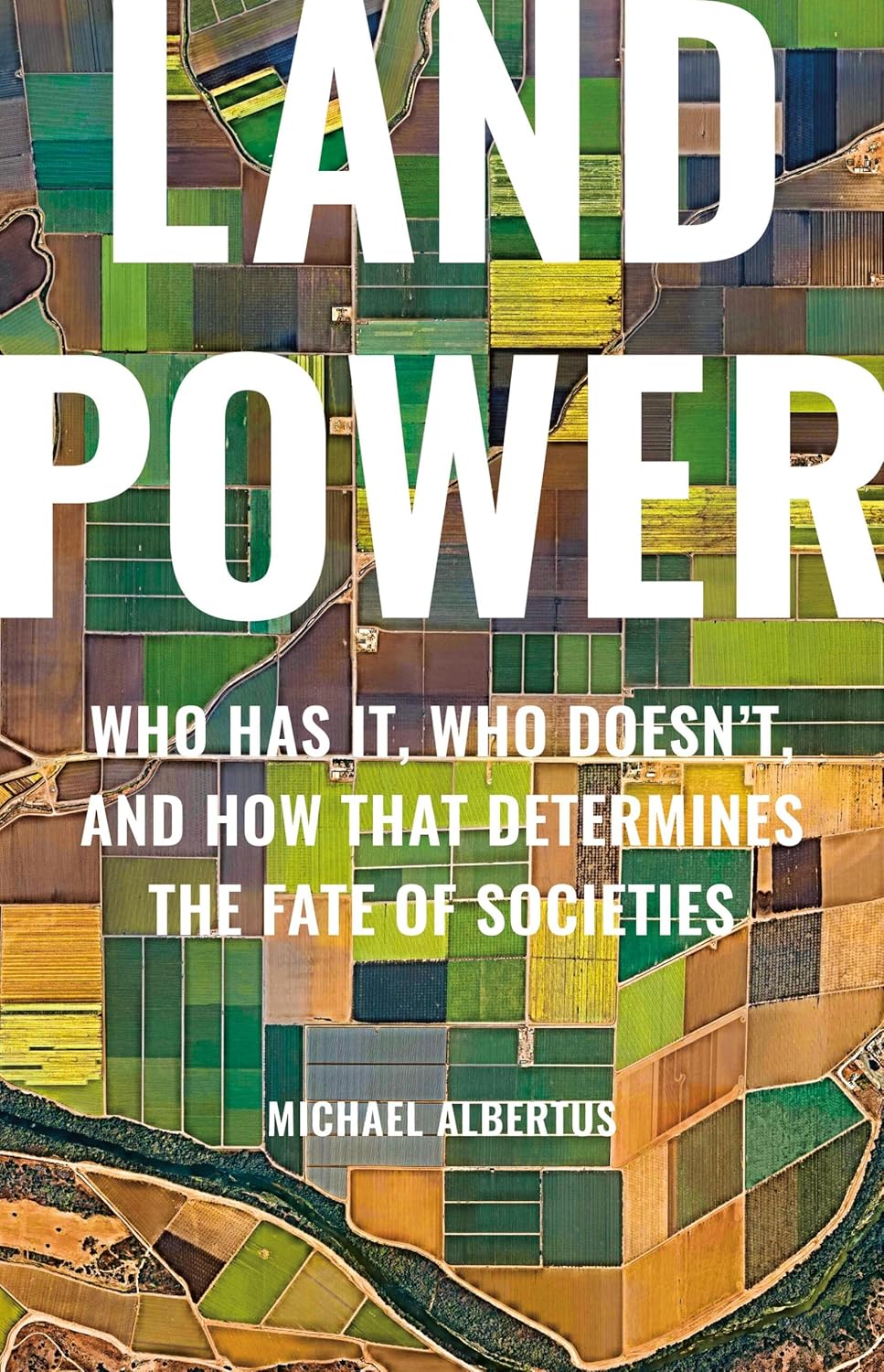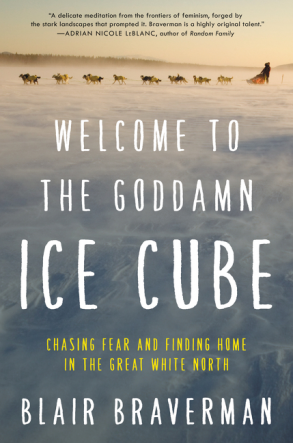Land Power: Who Has It, Who Doesn’t, and How That Determines the Fate of Societies
- By Michael Albertus
- Basic Books
- 336 pp.
- Reviewed by Yelizaveta P. Renfro
- January 8, 2025
The hazards of laying claim to the ground beneath our feet.

Land Power: Who Has It, Who Doesn’t, and How That Determines the Fate of Societies, by political scientist Michael Albertus, is a wide-ranging book that focuses on how land ownership developed, the ways in which power is vested in land ownership and transferred over generations, and how an array of land policies and practices spanning the globe have impacted societies. Though heavily researched, a hallmark of Albertus’ book is its clear and unadorned prose style, which renders its complex subject matter accessible and relevant.
Part I provides a great deal of historical context and then focuses on what the author calls the “Great Reshuffle,” an era of “population growth, state-making, and social conflict over the past two centuries” that sparked “dramatic upheavals in who holds the land in societies around the globe.”
In part II, “How Land Made Our Greatest Problems,” Albertus sets out to examine a host of issues related to land ownership that have arisen in the past couple of centuries. “The world we live in today is shaped by the choices countries made when the Great Reshuffle arrived on their doorstep,” he writes. “If they chose to steal the land from its indigenous occupants, they bequeathed to their descendants a country consumed by racial hierarchy and gender inequality and diminished by the loss of ecosystems and a heavily damaged natural environment.” This, he continues, has led to “some of society’s most intractable problems,” including racial and gender inequity, underdevelopment, and environmental degradation.
The chapters that follow examine these problems in detail, with case studies from around the world. In chapter three, “Lands Divided by Race,” Albertus examines land disputes between the Agua Caliente Band of Cahuilla Indians and the city of Palm Springs, California, as a microcosm of the prevalent inequities that still exist for Indigenous peoples. Statistics bear out the stark realities: As of 2018, 25 percent of Native Americans lived in poverty compared to 10 percent of whites. In addition, 24 percent of Native American adults have college degrees, compared to 47 percent of whites.
The disparities continue across the board. “Native Americans die at higher rates of diabetes, heart disease, and alcohol- and drug-related causes,” Albertus writes. “They have higher rates of mental healthy problems linked to historical traumas.” And many of these traumas, he shows, are linked to land dispossession, forcible removal, and ongoing property disputes.
In the next chapter, Albertus examines gender inequities in land ownership, first turning his attention to Canada’s 1872 Dominion Lands Act, which, in just over 60 years, “had given away over 100 million acres of land to men.” Identified as “one of the greatest wealth transfers to men in human history,” the act “almost entirely shut out” women from claiming homestead land in the Canadian West, which kept from them “the main economic opportunity in the Canadian prairies.” Coupled with a lack of inheritance rights, Canada’s system “rendered women vulnerable to poverty and hardship in the event of their husbands’ death or absence.” Impacts were felt long after the Canadian government closed public lands to the act in 1930, writes Albertus:
“Women born in the prairies prior to the end of the Land Dominions Act had the highest rates of poverty among Canadian women by the time they reached their sixties and seventies around the 1990s.”
He provides two other examples — the state of West Bengal in India in the 1970s and El Salvador in the 1980s and 1990s — to show countries that “discriminated against or ignored women and in doing so deepened their marginalization within society.”
Next, Albertus turns his attention to the environment. “Land settlement, land reallocation, and land use and management in the era of the Great Reshuffle have been responsible for some of the world’s worst episodes of environmental degradation and ecological collapse,” he writes, using China and Brazil as examples:
“In China, a Communist revolution followed by land collectivization and decollectivization drove massive deforestation, decimation of grasslands, soil erosion, and groundwater pollution. The country is now struggling to remediate these disasters at enormous cost and will never entirely complete the task. Half the world away, a military government in Brazil was simultaneously laying the groundwork for an environmental catastrophe. Beginning in the 1960s, the military opened up the Amazon rainforest for settlement…It is now being slashed and burned at an alarming rate and may soon cease to be the jewel of biodiversity and the carbon sink it once was. When the Great Reshuffle came to these countries, decisions over land locked in a bleak environmental fate.”
Though the case studies the author presents in the first two parts of the book are sobering, all is not lost. In part III, “Land as a Solution,” he offers stories of nations that have engaged in land-reallocation practices that give us cause for hope. For instance, Peru’s property-rights reforms “transformed the country into a model for property rights in the developing world.” Albertus goes on to offer Colombia and Bolivia as two model countries that have done much in extending property rights to women.
In the realm of righting environmental wrongs, Chile is presented as an exemplar. A partnership between philanthropists Doug and Kris Tompkins — who started buying up land in southern Chile for conservation in the 1990s — and the Chilean government led to “the largest public-private partnership in land restoration and conservation the world has ever seen.” The consequences have been momentous, says Albertus:
“From 2014 to 2018, Chile went from protecting just 4 percent of its land and sea area to protecting 36 percent. Vast areas of pristine land are now destined for preservation. An estimated 900 million tons of carbon will remain naturally sequestered in the soils and plant life of these parks.”
In the final chapter, “The Return of the Dispossessed,” Albertus turns his attention to the complexities of restoring land to Indigenous peoples, using South Africa and Australia as case studies. Both of these countries have deployed policies of land restitution, reparations, and reallocation to remedy historical wrongs and continuing racism. While much progress has been made — with South Africa transferring 34 million acres to Black farmers since the end of Apartheid, and First Nations peoples now holding title to about 40 percent of Australian lands — more work remains. Still, Albertus ends his book on a hopeful note:
“The demands to return land to dispossessed populations and decolonize society are gaining more and more traction, especially among young people and activists. These demands are radical and profound. But they are not unprecedented. The whole history of the Great Reshuffle shows us that societies have done the unthinkable over and over again: they have reallocated their lands in response to radical demands before. It’s not impossible to imagine them doing the same again — and doing it right this time.”
Land Power paints a compelling vision for a future in which continuing land reshuffling will provide more racial and gender equity and a higher quality of life for more people. Grounded in research and extensive fieldwork, Albertus’ book offers a way forward that takes into account our collective fate.
Yelizaveta P. Renfro is the author of a book of nonfiction, Xylotheque: Essays, and a collection of short stories, A Catalogue of Everything in the World. Her fiction and nonfiction have appeared in Glimmer Train Stories, Creative Nonfiction, North American Review, Colorado Review, Alaska Quarterly Review, South Dakota Review, Witness, Reader’s Digest, and elsewhere. She holds an MFA from George Mason University and a Ph.D. from the University of Nebraska.

